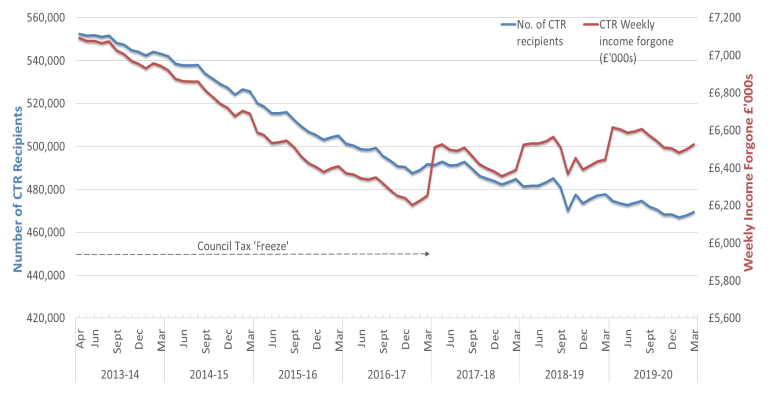Council Tax Reduction in Scotland 2019-2020
Council Tax Reduction (CTR) awarded by age, household structure, income sources and employment status, the deprivation index, and Council Tax band in the financial year from April 2019 till March 2020.
Council Tax Reduction in Scotland, 2019-20
(Published 24 June 2020)
This publication provides statistics on the Council Tax Reduction (CTR) scheme, which reduces the Council Tax (CT) liability of lower income households in Scotland. A Council Tax Reduction 'recipient' can be a single person or a couple, with or without children, since Council Tax is charged on a per-dwelling basis, rather than to individuals.
The statistics are based on monthly data extracts from local authorities, and cover the time period April 2019 to March 2020.

Key Points
- There were 469,370 Council Tax Reduction recipients in Scotland in March 2020. Those recipients live in slightly less than one-fifth of chargeable dwellings.
- The total number of Council Tax Reduction recipients in Scotland has gradually decreased by 15 per cent (83,010 recipients) between the start of the scheme in April 2013, and March 2020. However Council Tax and Council Tax Reduction reforms alongside annual increases in Council Tax since April 2017 have resulted in increases in the total weekly Council Tax Reduction awarded (as shown in Chart 1).
- The weekly income forgone by local authorities on Council Tax Reduction in March 2020 was £6.525 million.
- The provisional income forgone on Council Tax Reduction in Scotland in 2019-20 was £336.4 million.
- Of all Council Tax Reduction recipients in March 2020:
- 58 per cent (272,490 recipients) were in one of the 30 per cent most deprived areas in Scotland;
- 37 per cent (171,720 recipients) were aged 65 or over; and
- 16 per cent (74,360 recipients) were lone parents.
Changes in Council Tax and CTR changes since 1 April 2017
Chart 1 shows the effects of the following on Council Tax Reduction:
- The end of the Council Tax "freeze" which can be seen with the increase of Council Tax Reduction income forgone in April 2017, 2018 and 2019;
- The introduction of Universal Credit (UC) and the effects of which are described in Chart 9 in Section 3.1.
The figures reported in this publication should therefore be viewed in the light of the following changes which came into effect on 1 April 2017:
- The Council Tax "freeze" in place between 2008-09 and 2016-17 ended. In 2019-20 the Local Government Finance settlements included an agreement between the Scottish Government and local government for locally determined Council Tax increases to be capped at 3 per cent in real terms which was 4.79 per cent in cash terms. This was a change from 3 per cent in cash term from 2017-18 and 2018-19 following 9 years of Council Tax "freeze" (see Chart 1).
- The child element in the calculation of the Applicable Amount (see Figure 2) was increased from £66.90 per week to £83.63 per child.
- Council Tax Reduction recipients in receipt of below median income in Council Tax Bands E to H were eligible to receive Council Tax Reduction to the value of the increase in Council Tax due to the increase in multipliers to be paid by these dwellings relative to the Band D Council Tax rate.
Contact
Email: eddie.chan@gov.scot
There is a problem
Thanks for your feedback